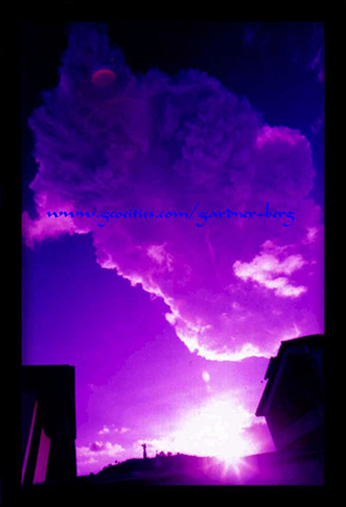
The Volcanic Eruption of Pichincha from our Hotel in Quito, ECUADOR
| Translate: Espa˝ol - Franšais - Deutsch - Italiano - Portuguŕs - Japanese - Korean - Chinese |

The Volcanic Eruption of Pichincha from our Hotel in Quito, ECUADOR
| Translate: Espa˝ol - Franšais - Deutsch - Italiano - Portuguŕs - Japanese - Korean - Chinese |


The continent of South America; a vast land mass with a history to match, offering today's traveller a vast range of pursuits of every type. Whether it be mountaineering, ecology, archeology, indigenous cultures, sun-seeking, festivals etc... - it's all here.
For us, however, and continuing on from our writings thus far (i.e. Mexico and Central America) accounting briefly the regions history, both Precolumbian and Postconquest.
In popular culture (i.e. in developed nations), words like Inca, Llama, Andes, Titicaca, Nazca are used when discussing South American indigenous cultures and, sometimes, South America in the general sense. But, however, the incredible diversity in cultures and traditions of South America's past, coupled with the outside influences of the present, has produced something that cannot be put in a 'little box'.

The earliest inhabitants of South America have been said to have lived as nomadic hunters and gatherers banded together in small groups (5000 BC). A widely accepted theory has these people marked as descendents of those who migrated across the Bering Strait from Asia during the Pleistocene Era, when the Great Ice Age lowered sea levels, allowing access into North America around 20,000 BC.
Beginning with Ecuador we will slowly make our way down and alongside the Andean 'backbone', to briefly study the Pre-Incan and Incan civilisations that developed here, in similar fashion as with Mexico and Northern Central America. Then, from Chile/Argentina we will head northward to Brazil to view the Amazon Basin and it's chief tribal groups that live there. We have a big task ahead of us but also a lot of time on our side....
November 10, 1999 -- A 1 and a half hour flight from Panama City to Quito, Ecuador. (Ecuatoriana)
As the plane made its descent into the Andes towards Quito we pass its neighbouring volcano, Guagua Pichincha. Of late, this volcano has been seen sending huge clouds of ash and steam over the capital (October 7, 1999 with 3 subsequent explosions before Christmas). It was an excellent view from above.
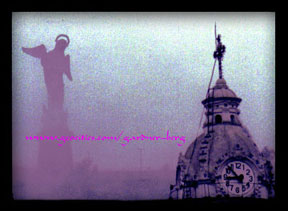
Ecuador is a small country (area approx. 270,000 sq.km); half of which is completely forested. The Andean mountains run north to south down the middle composing of 2 main ranges separated by a Central Valley 400 km long. Almost half the population live along this area.
For the next couple of days, we take things a little slow. Flying directly from sea-level to a place where the alitiude is 2800m (7200 ft) had us a little out of breath and the heart pounding loud from just a short walk.
We base ourselves in the old colonial section of Quito just a couple of blocks SE of the Government Palace, not far from the bus station (Terminal Terrestre).
Our first impression of Quito, from the plane window, was its huge size. Set in a 'bowl' flanked by its close neighbouring volcano, Quito is about 23 km south of the equator. And because of its altitude, the climate is very mild; at times rainy and cold with the occasional onslaught of hail.
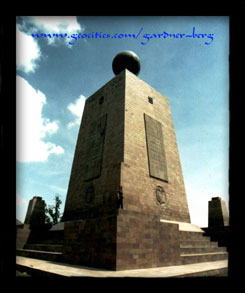
But despite its size, population and climate, it seemed fairly quiet and tranquil on our arrival as opposed to Panama City's loud and blaring bustle. But these are only first impressions...
November 12, 1999 -- We visit Quito's best arqueological museum - 'Museo Arqueologico del Banco Central'. Here we get a glimpse of South American Precolumbian ceramic and gold artefacts along with copious amounts of information of the many Pre-Incan tribal groups - only some of which we will cover during our travels.
November 13, 1999 -- We take a day trip north to visit Otavalo - a small town known for its textiles and it's huge market (only on Saturdays). The indigenous of Otavalo wear colourful attire and speak Quichua (Ecuadorean equivalent to Quechua) as their 1st language and Espa˝ol as their 2nd.
November 17, 1999 -- A teargas cannister exploded in the middle of a main street on our way to Quito's University theatre. Our first encounter with teargas had us reeling back with sore eyes and noses along with burning cheeks from our tears mixed with the gas.
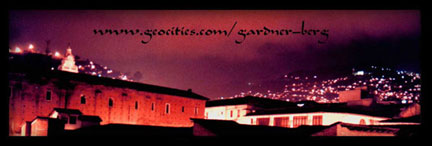
From what we can gather from local television news, there appears to be tension between police and students. But we found out later that the protests were related to the rapid decline in value of the nation's currency - the Sucre. Apparently, Ecuador has suffered a run of bad luck in recent years - falling export markets for bananas and coffee; the European Union raising import tariffs to allow bananas to come in from the Caribbean (which has closer historical ties with Europe). There was damage to its coastal plantations and many deaths in the villages in the area. Oil prices crashed in the late 80's with a recent explosion to the major pipeline, raising suspicion of sabotage. Huge amounts of finance was needed for repairs. The border war with Peru in 1995 also drained public finances.
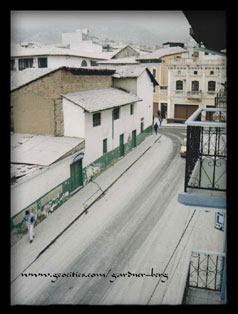
All these events and more have labeled Ecuador as a high risk nation for International loans.
So now, the falling currency has many people racing to the banks to withdraw their savings or to transfer their savings to a more stable currency e.g. the U.S. dollar. During our walks to the new town of Quito, we pass protest marches that seem to appear out of nowhere; riot police standing in large groups outside official buildings around the city. No violent confrontations seen, but there certainly is a 'pressure-pot' atmosphere around here.
November 18, 1999 -- Bus and Taxi drivers go on strike for a day. It may have been a blessing - the air was cleaner and walking to the New Town took less time with lessened traffic congestion.
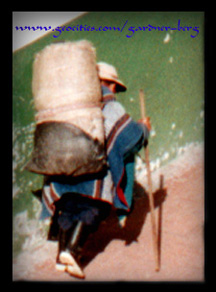
November 24, 1999 -- (1000) We catch a bus from Plaza Hermano Miguel and head north (1 hour) to 'Mitad Del Mundo' - 'Middle of the World' or the Equatorial Line Monument which also houses an interesting museum displaying photos, facts and artefacts from various Indian cultures.
November 25, 1999 -- (1000) From Terminal Terrestre we head south for a day to visit Saquisili for their town market - the country's most important for the people of remote Indian villages. We also had magnificent views of Volcan Cotopaxi on the way down.
November 26, 1999 -- An overnight volcanic explosion from Quito's Guagua Pichincha had the entire city covered with a blanket of ash this morning.
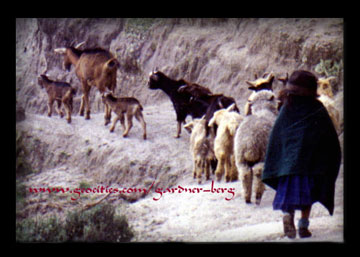 The problems caused by volcanic ash was very evident when we decided to catch a city bus to see a movie. Besides the necessary use of breathing masks, vehicles would stall from clogged air-filters or overheat from blocked airflow through radiators.
The problems caused by volcanic ash was very evident when we decided to catch a city bus to see a movie. Besides the necessary use of breathing masks, vehicles would stall from clogged air-filters or overheat from blocked airflow through radiators.
Most of the city's people displayed remarkable patience under these circumstances. But everyone, including ourselves, quietly prayed for rain. It arrived 5 days later.
December 10, 1999 -- A decision was made to stay in Ecuador to see Christmas and the New Millennium with couple of friends.
December 24, 1999 -- Champagne, cheese and a movie with friends at our hotel.
December 25, 1999 -- (noon) We prepare a Christmas dinner at the hotel. An excellent meal consisting of roast chicken, mashed potatoes, vegetables, bread, cheese, wine, spirits and, of course, dessert. A very pleasant afternoon.
Photos and Text Copyright ę 1999-2001 Gardner-Berg. All rights reserved.
Sources of Further Reading-
Elliot, Elizabeth. "The Savage My Kinsman" 1996.
Howay, Frederick. "Atahualpa" 1978
MacDonald, Theodore. "Ethnicity and Culture Amidst New Neighbors: The Runa and Ecuador's Amazon Region".

